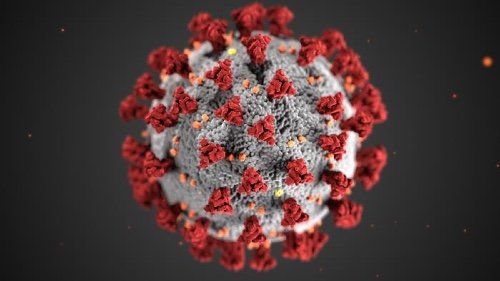4 Categories for Reporting COVID-19 CT Findings
RSNA releases a consensus statement to reduce reporting variability around the virus.

Clinical knowledge about COVID-19 continues to emerge and change daily. In an effort to help standardize how radiologists convey any associated findings, the Radiological Society of North America (RSNA) released a consensus statement this week designed to reduce reporting variability.
Drafted by experts from nine academic medical centers, and published on March 25 in Radiology: Cardiothoracic Imaging, the statement outlines four categories for reporting CT findings of possible COVID-19, as well as standardized language. The statement was endorsed by the American College of Radiology (ACR) and the Society of Thoracic Radiology.
Overall, radiology experts are urging caution around including COVID-19 in a report because it can set a string of events in motion, including stringent infection control measures, and can cause heightened stress for providers and patients. In addition, it can carry potential economic and workflow implications.
But, there are situations where mentioning COVID-19 in a report is appropriate and necessary. For these cases, providers need guidance on how to relay those findings. Ultimately, according to Suhny Abbara, M.D., editor of the journal and chief of cardiothoracic imaging at the University of Texas Southwestern Medical Center in Dallas, this consensus statement is designed to augment provider communication and help lessen any anxieties around managing a patient load that will continue to increase for the foreseeable future.
“We believe it is important to provide radiologists and referring providers guidance and confidence in reporting these findings and a more consistent framework to improve clarity,” Abbara said in an RSNA statement.
Currently, radiological societies are recommending against using CT as a screening method for COVID-19 detection, but how CT is implemented during this outbreak could change over time, they said.
“We anticipate that the use of CT in clinical management, as well as incidental findings potentially attributable to COVID-19 will evolve,” the authors wrote. “We believe it important to provide radiologists and referring providers guidance and confidence in reporting these findings and a more consistent framework to improve clarity.”
Doing so requires clear and frequent communication between radiologists and other healthcare provided, they added. And, as the volume of exams on patients with suspected infection continues to rise, radiologists will continue to identify incidental findings that suggest COVID-19 pneumonia. In these cases, they must decide whether to mention the virus in their report.
Abbara and his colleagues proposed the following four categories for reporting CT findings. They noted, however, this is only a guide and that providers will likely need to work with their home institutions to design tailored approaches.
Typical features: These are characteristics that are reported to be frequently and more specifically associated with COVID-19 pneumonia. The principal differential diagnosis includes some viral pneumonia, especially flu, as well as acute lung injury patterns, particularly organizing pneumonia.
Indeterminate features: These are findings that have been reported with COVID-19 pneumonia but aren’t specific enough for a confident radiological diagnosis. For example, diffuse ground-glass opacity (GGO) without clear distribution is common in COVID-19 pneumonia, but it also occurs in many other diseases, such as acute hypersensitivity pneumonitis, that are difficult to determine by imaging alone.
Atypical features: These findings have been reported as uncommon or not-occurring in COVID-19 pneumonia. Instead, they are typical of other diseases, including lobar or segmental consolidation associated with bacterial pneumonia, cavitation from
necrotizing pneumonia, and tree-in-bud opacities with centrilobular nodules.
Negative for pneumonia: This language refers to scans with no parenchymal abnormalities, specifically GGO and consolidation, that can be attributed to infection. It’s important to remember that it’s possible no findings will be seen on CT in early COVID-19 infection.
The group stressed this language does not equate to a confirmed diagnosis, adding that radiologists should always follow the ACR Practice Parameters for Communication of Diagnostic Imaging Findings.
“The reporting language does not offer an exact likelihood for COVID-19 pneumonia, which depends on several factors, including prevalence in a community, exposure, risk factors, and clinical presentation,” the group wrote. “Rather, the reporting language focuses on CT findings reported in the literature and the typicality of these features in COVID-19 pneumonia rather than other diseases.”
Study with CT Data Suggests Women with PE Have More Than Triple the One-Year Mortality Rate than Men
April 3rd 2025After a multivariable assessment including age and comorbidities, women with pulmonary embolism (PE) had a 48 percent higher risk of one-year mortality than men with PE, according to a new study involving over 33,000 patients.
The Reading Room: Racial and Ethnic Minorities, Cancer Screenings, and COVID-19
November 3rd 2020In this podcast episode, Dr. Shalom Kalnicki, from Montefiore and Albert Einstein College of Medicine, discusses the disparities minority patients face with cancer screenings and what can be done to increase access during the pandemic.
Predicting Diabetes on CT Scans: What New Research Reveals with Pancreatic Imaging Biomarkers
March 25th 2025Attenuation-based biomarkers on computed tomography (CT) scans demonstrated a 93 percent interclass correlation coefficient (ICC) agreement across three pancreatic segmentation algorithms for predicting diabetes, according to a study involving over 9,700 patients.
Can Photon-Counting CT be an Alternative to MRI for Assessing Liver Fat Fraction?
March 21st 2025Photon-counting CT fat fraction evaluation offered a maximum sensitivity of 81 percent for detecting steatosis and had a 91 percent ICC agreement with MRI proton density fat fraction assessment, according to new prospective research.